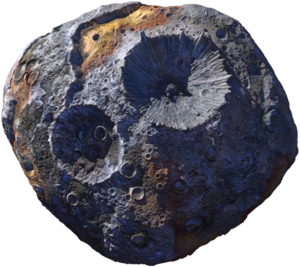
College of Engineering Unit:
Not your average Asteroid
The Psyche mission revolves around queries concerning a metallic asteroid. Arizona State University (ASU) is leading a study funded by the National Aeronautics and Space Administration (NASA) to conduct orbits around Psyche. The orbiter will launch and begin its journey on October 5th, 2023. With this mission, ASU plans to analyze the building blocks of solar system formation and educate the conglomerate of humanity. Future scientists and engineers may propose a return mission in the future to perform touchdown maneuvers to analyze the metallic body in further detail. This project focused on the foot subsystem for a prospective lander mission.
Unique Problems Need Unique Solutions
Due to Earth's distance from Psyche (~2.5-3.3 AU), minimal information regarding the asteroid's planet properties exists. A baseline knowledge is achieved once the Psyche orbiter completes its mission; however, it is projected to cruise for six years before its arrival. This constraint led to the provision of limited hypotheticals from the Psyche mission to take into consideration for the design phase of project 611.2. The following includes the hypothesized planet properties of Psyche:
- Average Diameter: ~ 140 miles (226 km)
- Surface Area: ~ 64,000 miles2 (165,800 km2)
- Density: ~ 3,400 - 4,100 kg/m3
- Gravity: ~ 0.144 m/s2
- ~ 30% - 60% Metal Volume
- Remnants of a Magnetic Field
-
Multiple Surface Compositions
- Rock, Metal, Loose Regolith, etc.
- Extreme Geological Features
Surface Fixation Tactics
Team 611.2, driven by innovation, fabricated a low-cost landing foot alternative for aerospace vehicle buses designed to perform small-body exploration missions. In 20 weeks, the team manufactured, tested, and iterated the selected design for under $500. The foot prototype has a dry mass of ~3.85 kilograms (maximum wet mass: ~5.67 kilograms). This design incorporated multiple preventative measures to counter surface bounce, a common problem for small-body exploration missions. The landing foot comprises two anchor mechanisms (harpoons and thermite) in an open-housing concept, i.e. no external shell surrounding the anchors. The outer-most cylinders hold the harpoons with their actuation components attached in their respective housing along the side (gas cylinder, winch, motor, etc.). The middle cylinder (sealed) acts as the main point of connection for the legs of the lander and contains a thermite composition that works in conjunction with the harpoons to ensure a static mass after touchdown. The following are assumptions from the concept generation phase:
-
The landing site may be inclined; the landing site is not necessarily flat.
-
The lander may touchdown in a position that is not oriented perpendicular to the asteroid’s surface (+/- 20°).
-
The lander will touchdown using passive soft-impact techniques.
-
The lander will not return to Earth.
-
The lander fuselage will act as a rigid body through all life phases.
-
The lander's total wet mass is 2500 kg on Earth.
-
Assumptions for excessive lander weight increase the foot's safety factor for buckling under a realistic mass.
-
The dual harpoons, located on opposite ends of each foot, fire to penetrate the surface of Psyche. The winches within the harpoon mechanism reel the feet to promote maximum surface contact with Psyche. Once harpoons establish the initial anchor points, a relay will allow the ignition circuit to draw current through a nichrome wire to auto-ignite the thermite composition. An induced vacuum draws liquid thermite downward through the bottom orifice once the barrier plate melts to create a root system underneath the surface of Psyche. Once the thermite is expelled, the surface temperature of Psyche (~ 160 K) promotes the quenching of the solidified roots. The optimum quantity of anchor points is nine total, across 3 feet. Due to the unknown nature of the surface composition and its features, nine total anchor points may not be achievable; however, team 611.2 anticipated these possible scenarios. The following are the hypothesized case scenarios of the Psyche surface:
-
Fully Metallic
- Harpoon and Thermite penetrate the least; Thermite fuses/welds with surface
- 3 - 9 Anchor Points
-
Metallic/Rock
- Harpoon penetrates deeper than Case 1; Thermite penetrates deeper than Case 1 (dependent on the porosity of the surface); Thermite fuses/welds with metal compositions
- 9 Anchor Points
-
Rock
- Harpoon penetrates deeper than Case 2; Thermite penetrates the deepest vertically (dependent on the porosity of the surface)
- 9 Anchor Points
-
Loose Regolith
- Harpoon penetrates the deepest; Thermite spreads horizontally to promote stability
- 6 - 9 Anchor Points
Team 611.2 determined that the baseline values for the anchor mechanisms must be designed around Case 1 to ensure functionality across all presented scenarios. For example, the firing pressure of the harpoons is set to a value of 4000 psi, thus able to penetrate possible crystalline metallic surfaces. Further specifications regarding the foot subsystem and its respective components can be found in the supplementary resources listed on this webpage.
The Psyche mission wishes to provide explanations for planetary science worldwide with the collaboration of Team 611.2 and the stakeholders. This project encapsulates the innovation and reaches for new bounds required to impact the industry positively and safely. The team incorporated ethical engineering practices to provide purposeful, functional, and new applications of technology that guarantee success despite the scenario. Failure is not an option.
Future Applications/Iterations
-
Harpoon Aerodynamics
-
Rifling of the Harpoon Cylinder and Addition of Pitched Barbs
- Deeper Penetration Due to an Increase in Rotational Energy
- Greater In-Flight Stability Due to Angular Momentum
-
Rifling of the Harpoon Cylinder and Addition of Pitched Barbs
-
Compression Absorbers
-
Addition of Honeycomb Structures
- Reduce Unnecessary Buckling of the Cylinders
- Absorb Impact Forces
-
Addition of Honeycomb Structures
-
IED Inhibitor
- Repurposing the Thermite Mechanism for Explosive Ordinance Disposal (EOD)
Acknowledgments
Parker Choc, Tyler McHuron-Guss, Kelton Orth, Sheriff Jerry Williams, and the Refuge.
Project Website(s):
Industry Sponsor(s):
| Attachment | Size |
|---|---|
| 1.13 MB | |
| 12.47 MB | |
| 22.65 KB |